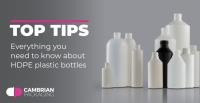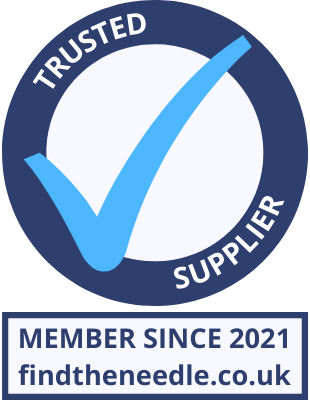 Add My Company
Add My Company
Sign In
HDPE bottles – everything you need to know
23-05-2022

HDPE bottles – everything you need to know
HDPE bottles are popular because high density polyethylene is widely recycled in standard facilities, and the material is a good all-rounder used for varied applications.
We stock HDPE bottles in various design, see here, also HDPE spray bottle sin 300ml to 1000ml here. This article seeks to answer some of the commonly asked questions about HDPE bottles.
HDPE bottles vs PET bottles
HDPE bottles (High-density polyethylene) are lightweight, durable and shatterproof, with a translucent matt finish in their natural form. HDPE can be coloured in virtually any colour; black white and natural are kept in stock with other colours available to order. HDPE is compatible with most acid and alkaline solutions, but has limited compatibility to solvents. The minimum continuous operating temperature for HDPE bottles is -50°C.
PET bottles (Polyethylene Terephthalate) offer a luxury gloss finish and are usually completely clear. White, black and colours are possible subject to production minimums. They offer good solvent compatibility, but they have limited compatibility to caustic solutions. PET bottles tend to be used where the product needs to be seen or is a solvent solution and they are very popular with car care products (they are ideal for products such as de-icer). The minimum continuous operating temperature for PET bottles is -20°C.
For full material information, head over to our Knowledge page, and find our Quick Reference Materials Guide and Materials Temperature Range Guide.
What are they used for?
HDPE bottles are more resistant to corrosive chemicals, so they tend to be used for substances such as bleach, detergents and shampoos. They are particularly popular with cleaning products such as all-purpose cleaners, but they are used in a variety of industries for a variety of uses and can be used in packaging for lotions, soaps, sauces and polishes.
HDPE bottles for pharmaceutical use and tablets
We offer a range of HPDE jars which are ideal for pharmaceutical products or even fishing baits. You can find the lids and containers here. Our white HDPE 100ml tampertainer jar is perfect for supplements or over the counter medication because of its tamper-evident properties. You can read more about tamper-evident containers in our blog.
HDPE bottles for chemicals
Popular choices for HDPE bottles which need to contain chemicals include our Elan, Conway and Ceri spray bottles.
Our Elan bottles come in sizes 500ml, 750ml and 1000ml. There is a large label area and the shape is suited to high speed filling and labelling. Fitted with 28/410 necks across the range and a TS1 snap on neck on the 750ml size, they are stocked in natural and white from stock – other colours are available to order.
Ceri HDPE bottles are available in 500ml and 750ml with a 28/410 screw neck as standard. They can be ordered from stock in white and natural with other colours available to order. They have a large, simple label area.
Our Conway design of HDPE bottles is a great choice for applications where a smaller spray bottle is needed, available in 300ml and 500ml.
Can you get clear HDPE bottles?
If you are looking for a widely recycled plastic packaging solution where you can see the product inside the bottle, we would recommend clear PET plastic. HDPE bottles can be translucent, but they are not as clear as PET alternatives.
This is why PET is often used for plastic juice bottles, rather than HDPE, though HDPE tends to be more popular with smoothie bottles (perhaps when more attention needs to be on the branding rather than the appearance of the product).
Fluorinated bottles and containers/jars
Sometimes, there are certain products that can cause bottles to become misshapen, or products to spill. One way to avoid this is to consider the fluorination process, which can be costly. We’ll be pleased to deliver standard HDPE bottles to a third party to be fluorinated on a customer’s behalf.
PET is inherently resistant to many solvents, so may be a better option than fluorinating HDPE. Please speak to our packaging experts for advice on what material suits your liquid product. Call us on 01686 611360 for options and free samples overnight.
Can HDPE bottles be recycled?
HDPE bottles are widely recycled. Check with your local council for mention of recycling milk bottles, yoghurt pots, soap dispensers, bleach and detergent bottles, shampoo bottles, and ice cream tubs for example. The resin identification code for HDPE is 2, usually shown on the bottom of the bottle. For more information about resin identification codes, read our blog on the subject by clicking the link.
What are resin identification codes
Can HDPE bottles be reused?
According to Healthline, HDPE plastic is currently considered a low-hazard plastic with a low risk of leaching. Its is designed to ward off bacterial growth and it’s not believed to be affected by heat or sunlight. However, most HDPE bottles are designed for single use, and should be recycled. By recycling the bottle, you are adding to the stock levels of rHDPE, so more materials can be made from recycled plastic.
HDPE can be recycled into recycling bins, plastic lumber, picnic tables, pipes, crates, non-food bottles (but WRAP has helped to create a process for rHDPE suitable for food containers), anti-freeze bottles, HDPE bottles for motor oil, laundry cleaners, cleaning products, conditioner, and shampoo. It can also be used for flower pots and floor tiles.
Why is HDPE used for milk bottles?
HDPE bottles are strong and lightweight, which helps to reduce the weight of heavy volumes of liquid. It also means the milk can be protected during transportation, without adding to the total weight and upping carbon emissions (two things which couldn’t be achieved with the old-fashioned glass bottles).
Did you know that while HDPE plastic milk bottles can break when dropped from a significant height, they would not shatter?
HPDE is also a food-grade plastic, which means it’s safe for storing perishable goods for a short amount of time. The plastic is also able to be blow moulded into different shapes, which is great for the style of milk bottles with handles.
WRAP has been working with industry partners to create the worlds’ first process to recycle HDPE milk bottles back into food grade recycled HDPE (rHDPE) for use in new milk bottles, closing the loop! Despite some supermarkets experimenting with alternatives, HDPE bottles are a clear winner.
For more information on HDPE bottles – everything you need to know talk to Cambrian Packaging
Enquire Now
List your company on FindTheNeedle.

